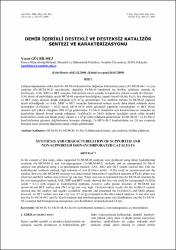Demir içerikli destekli ve desteksiz katalizör sentezi ve karakterizasyonu
Abstract
Çalışma kapsamında silika bazlı Fe-MCM-48 katalizörleri doğrudan hidrotermal sentez (Fe-MCM-48-1) ve yaş emdirme (Fe-MCM-48-2) metotlarıyla, desteksiz Fe-Mo-O katalizörü ise birlikte çöktürme metodu ile üretilmiştir. AAS, XRD ve BET sonuçları hidrotermal sentez metodu ile katalizöre yüksek oranda (Fe/Si(katı) = 0,56) demir eklenebildiğini ancak MCM-48 yapısının bozulduğunu, yapıda önemli ölçüde Fe2O3 fazı oluştuğunu ve BET yüzey alanının düşük olduğunu (214 m2/g) göstermiştir. Yaş emdirme metodu ile MCM-48 yapısına demir eklendiğinde ise AAS, XRD ve BET sonuçları hidrotermal senteze oranla daha düşük miktarda demir eklendiğini (Fe/Si(katı) = 0,12) ancak MCM-48’in kübik gözenekli yapısının korunduğunu ve BET yüzey alanının çok yüksek olduğunu (982 m2/g) göstermiştir. Fe-Mo-O katalizörü için karakterizasyon sonuçları ise katalizörün düzenli kristal yapıda olduğunu, Fe2(Mo4O)3 ve MoO3 fazlarını içerdiğini ancak silika destekli katalizörlere oranla çok düşük yüzey alanına (12 m2/g) sahip olduğunu göstermiştir. Fe-MCM-48-1 ve Fe-Mo-O katalizörlerinin gözenek dağılımlarının homojen olmadığı, Fe-MCM-48-2 katalizörünün ise 2,8 nm civarında homojen mezo gözenek dağılımına sahip olduğu görülmüştür. In the content of this study, silica supported Fe-MCM-48 catalysts were produced using direct hydrothermal synthesis (Fe-MCM-48-1) and wet-impregnation (Fe-MCM-48-2) methods and an unsupported Fe–Mo-O catalyst was produced using a co-precipitation method. AAS, XRD and BET results showed that with the hydrothermal synthesis method, high amounts of iron (Fe/Si(in solid) = 0.56) could be incorporated into the catalyst, however, the MCM-48 structure was deteriorated, formation of significant amounts of Fe2O3 phase was observed and BET surface area (214 m2/g) was low. When iron was incorporated into the MCM-48 structure by the wet-impregnation method, AAS, XRD and BET results showed that less iron could be incorporated (Fe/Si(in solid) = 0.12) with respect to hydrothermal synthesis, however, cubic porous structure of MCM-48 was preserved and BET surface area (982 m2/g) was very high. Characterization results for the Fe-Mo-O catalyst showed that the catalyst had regular crystalline structure and possessed the Fe2(Mo4O)3 and MoO3 phases, however, its BET surface area was very low (12 m2/g) compared to the silica based catalysts. It was also seen that the Fe-MCM-48-1 and Fe-Mo-O catalysts had non-homogeneous pore size distributions and the Fe-MCM- 48-2 catalyst had homogeneous mesoporous size distribution centered around 2.8 nm.
Source
Gazi Üniversitesi Mühendislik Mimarlık Fakültesi DergisiVolume
24Issue
2URI
http://www.trdizin.gov.tr/publication/paper/detail/T1RBMk1EYzM=https://hdl.handle.net/11421/21348
Collections
- Makale Koleksiyonu [179]
- TR-Dizin İndeksli Yayınlar Koleksiyonu [3512]


















